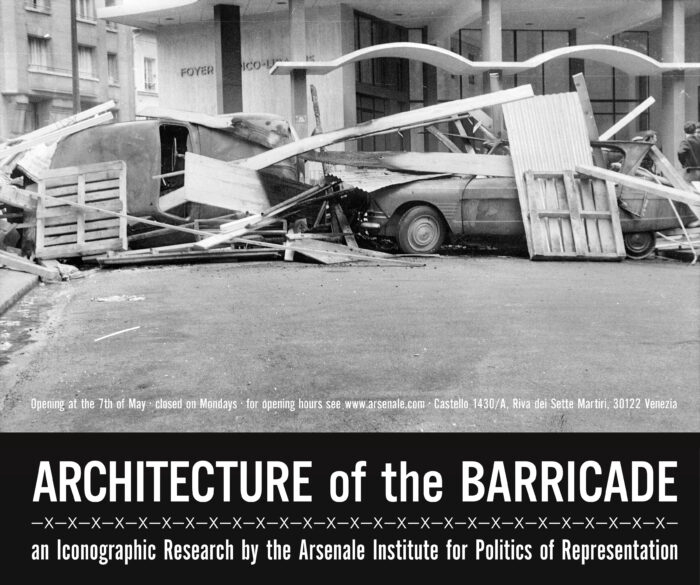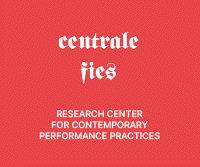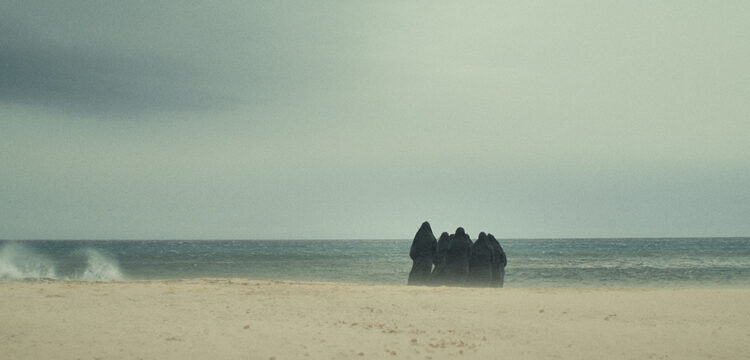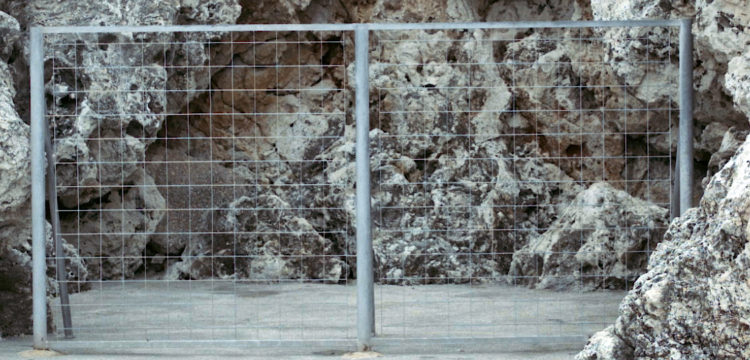Echoes from the Mediterranean Sea
Feminist voices through the lens of literature and translation
Curated by Angel Moya Garcia, the solo exhibition Appunti dal mare by Anna Raimondo has been showcased from May 18 to September 29, 2024 at Dello Scompiglio in Lucca (Italy). The exhibition featured the video Mediterraneo (2014) and Derrière la mer (2018), a sound installation comprising sheet music, fabric, and a handmade booklet. This work recently appeared at the Malta Biennale 2024 under the theme “Can You Sea?: The Mediterranean as a Political Body.”
Anna Raimondo’s video work Mediterraneo (2014) begins with a simple, evocative image: an empty glass. As the minutes pass, viewers witness the slow, deliberate filling of the glass with water, drop by drop. Meanwhile, the artist’s voice repeats “Mediterraneo, Mediterraneo, Mediterraneo,” in a rhythmic voice that creates a hypnotic yet unsettling atmosphere. Over the course of twenty minutes, a paradoxical emotional tension builds, contrasting the urgent desire to see the glass fill with the slow, almost torturous process. As the blue liquid rises, Raimondo’s once clear voice falters, stumbles, chokes, and eventually drowns. The repetitive mantra and the visual of the rising water serve as a poignant metaphor for the Mediterranean Sea, a site of tragedy where countless lives have sought rescue. The work encapsulates the association between the glass and the mouth “the cavity through which the body swallows life’s lymph,” creating an emotional connection between the viewer and the subject.
Throughout history, the Mediterranean Sea has been a cradle of civilization, trade, and cultural exchange. Yet today, the Mediterranean Sea is also a site of tragedy. It has become with migration, as thousands attempt perilous crossings to escape war, poverty, and persecution, hoping to reach European shores. This context informs much of Raimondo’s work. The Mediterranean, as represented in Mediterraneo, becomes a political body as stated by the artists, using the sea as a metaphorical border that divides and unites cultures while becoming the scene of human suffering.
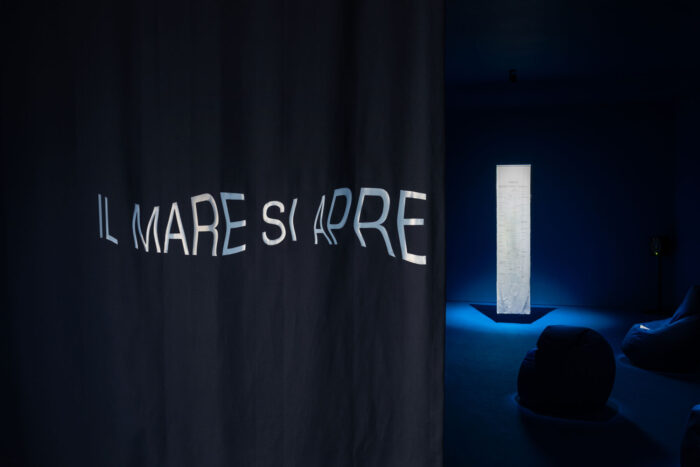
Sound in Raimondo’s work is not merely a background element; it is fundamental for evoking emotion and creating meaning. In Derrière la Mer, the audience is enveloped in a soundscape that mimics the sea, with voices flowing like waves. The sound installation transforms the gallery space into a sensory experience, guiding the audience through the layered emotions of migration and displacement. Mediterraneo (2014) transcends a simple video/performance piece, functioning as an emotionally charged meditation on the Mediterranean Sea. The slow, deliberate pace of the water filling the glass parallels the slow accumulation of suffering and lives lost in the Mediterranean. This glacial filling of the glass contrasts with the immediate tension viewers feel, a metaphor for the impatience of those witnessing the migrant crisis from afar, frustrated by the lack of action. And also, the recurring mantra “Mediterraneo” functions both as a linguistic repetition and a powerful auditory representation of the sea. In psychoanalytic terms, repetition compulsion seems to refer to the human need to repeat traumatic events in the hope of mastering them. Raimondo’s repetition serves as a reminder of how these tragedies, like the refugee crisis, continue to unfold in a relentless cycle. The piece demands viewers consider not only the political dimensions of the sea but also their own helplessness in watching the situation evolve, powerless to intervene.
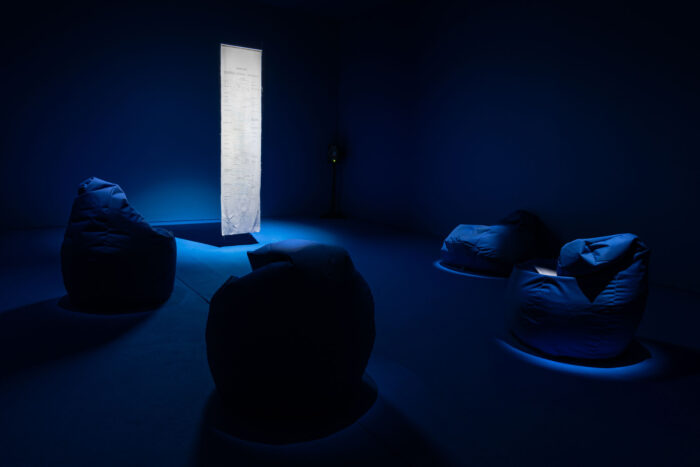
Entering the dimly lit room through a dark curtain inscribed with “Il mare si apre ma non si pezza,” (The sea opens but does not heal) visitors are greeted by Derrière la mer. The poetic phrase “Il mare si apre ma non si pezza” evokes the sea’s enduring resilience and unity, inviting contemplation of its vast depths and continuous existence. Beanbag chairs arranged in a semi-circle facing a fabric sheet resembling a banner suggest an interactive setup that invites the audience to sit and engage actively with the installation. The layout of Derrière la Mer enhances the experience of visitor to immerse themselves in the sound installation while the seating arrangement is both intimate and communal, drawing attention to the shared human experiences evoked in the work. This curatorial decision to create an interactive space where the audience is not just a passive observer but an active participant in the unfolding Raimondo’s work narrative. Titled “Derrière la mer,” the text on the banner inscribes water currents and waves, using lines that form visual scripts and phrases resembling calligrams. These written lines evoke the waves of the Mediterranean, suggesting the constant movement of people, ideas, and cultures across its waters. Voices intertwine with each other, following and responding in a fluid dance of sound and meaning. Calligrams are a visual form of poetry where the text forms a picture particularly significant in Raimondo’s work. They serve to blur the line between text and image, much like Raimondo’s work blurs the boundaries between sound, video, and performance. This blending of mediums reflects the nature of being in the Mediterranean region, where cultures have historically intertwined. The sound installation blends languages in an incantatory manner, reflecting the multiplicity of voices and narratives, a recurring theme in Raimondo’s work. The Derrière la mer banner is structured into three parts: Vers la mer (Toward the Sea), Traverser la mer (Crossing the Sea) and Au-delà de la mer (Beyond the Sea). The journey begins with performers exploring the voices of the sea through vocal improvisation, setting the stage for an introspective and expansive experience. In the second part, performers delve into the unseen depths of the sea, layering their voices to evoke its mysteries, turbulence, and quietude. The final section navigates back to solid ground, intricately weaving themes of the sea’s cyclical rhythm and the profound symbolism of new places and soil.
The use of multiple languages highlights the diversity of stories and voices present in the Mediterranean. Sound art as a medium has a unique ability to engage the body and mind. As theorist Brandon LaBelle notes “Sound occurs among bodies (…) Sound is produced and inflected not only by the materiality of space but also by the presence of others, by a body there, another there and another over there.” Somehow LaBelle focuses on the sound as a social event and the social event’s multiplicity viewpoints. In Raimondo’s work, the shared social experience invites the audience, seated in the arrangement of the room in Derrière la mer, to connect with the voices of the sea—those who have perished in its depths and those who continue to seek refuge across its waters.
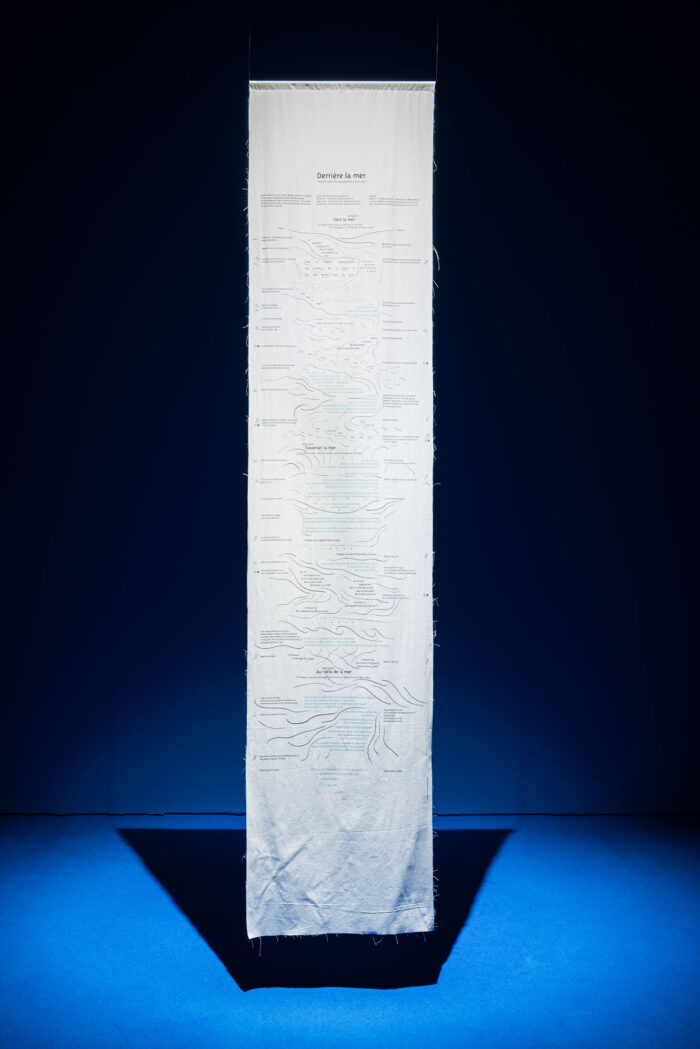
In Raimondo’s work, playful phonetic, linguistic, and cultural references converge in her sound and video pieces. By translating and interpreting the narratives, Raimondo provides an exploration that enriches the audience’s understanding, offering a rich experience that invites empathy. Raimondo explores internal multiplicity and the richness of multiple perspectives within oneself, which seems to resonate with themes of identity and place.
During my involvement with the international critical thinking journal Transeuropéenne during the beginning of the Arab Spring, the review project “Traduire la Méditerranée” (Translation Mediterranean) emphasized the need for new narratives within the region’s societies. Reflecting on Raimondo’s work, it reminds me of the way she seeks a deeper contemplation of cultural intersections and personal narratives. Playful phonetic, linguistic, and cultural references converge in her sound, video installations, and performances. By documenting, translating, and interpreting these narratives, Raimondo provides an exploration that enriches the audience’s understanding, offering a rich experience that evokes empathy. She explores internal multiplicity and the richness of multiple perspectives within oneself, resonating with the themes of cultural exchange and translation. The need for new narratives—stories that reflect the multiplicity of experiences and identities in the region—has never been more urgent.
Raimondo’s engagement with sound as a feminist tool is further explored in her project New Genders of Listening, where she investigates “gendered listening” through interviews with sound artists, performers, and composers. By incorporating their voices and bodies into her work, Raimondo articulates materialist feminist strategies using digital tools. One significant example is her sound piece Me, My English, and All the Languages of My Life (2016), which won the Palma Ars Acustica award. In this work, Raimondo draws on her own nomadic experiences and the intertwining of languages—Italian, Spanish, French, and English—shaping her life narrative. The installation highlights the challenges of learning new languages and adapting to new cultural contexts, blending them into a singular soundscape that mirrors the complexity of identity in a globalized world. The use of multiple languages highlights the diversity of stories and voices present in the Mediterranean.
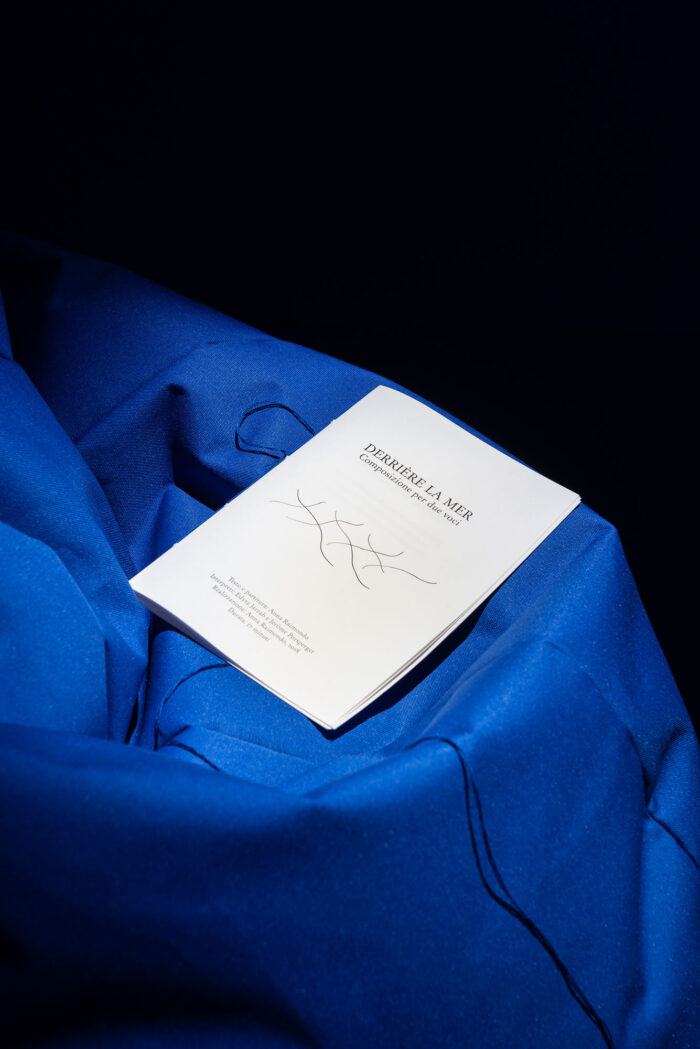
The curated selection of works in the exhibition Appunti dal mare evokes a profound sense of resilience and urgency, serving as a poignant reflection on the humanitarian crisis unfolding in the Mediterranean. Anna Raimondo deftly employs a harmonious interplay of voices, visual motifs, and writings to navigate the turbulent waters of migration and despair. Each voice and visual script within the installation draws from narratives and references that vividly capture the physical and emotional dimensions of these challenges. Through a migrant journey embarked on for their beliefs, hopes, and dreams, Raimondo compels viewers to confront these pressing issues with empathy and introspection.
To deepen the understanding of Anna Raimondo’s work, it is crucial to examine how her art addresses the contemporary challenges of migration through a lens of personal narrative and collective memory. By weaving her own experiences with language and displacement into her installations, she creates a space where viewers are prompted to reflect on their own relationships with language, identity, and belonging. This connection is enriched by my own journey, as I navigate the challenges and nuances of living in different languages and cultures. The exhibition thus not only documents the harsh realities faced by refugees seeking safety but also prompts a deep reflection on our shared responsibility in the face of contemporary adversity.
The artist blends cultures and languages, presenting diverse perspectives on the sea as an unbreakable and unifying element, not meant for division. As seen in gendered listening Raimondo reflects on the multiplicity of voices present in the Mediterranean, drawing attention to the diversity of stories and experiences that often go unheard. Her work emphasizes the importance of listening as an active, political act—one that acknowledges the voices of those marginalized by borders, both geographic and cultural. This reminds me of novelist Nancy Huston, who transcended the limits of bilingualism by self-translating polyglot texts. In her narrative fiction, she creates multiple voices, which is characteristic of feminine writing: “as a woman, as a bilingual, as a writer, creator, contributor to the feminist movement, as a mother, she has an emotional arsenal with which to make her characters speak.” These multiple voices appear as commentary, whispers, or screams… In Raimondo’s sound installation Derrière la mer, we encounter multiple voices intertwined with multiple texts.
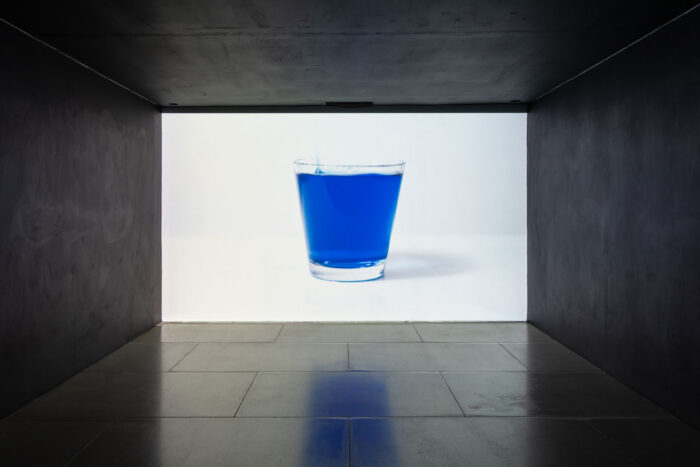
Just as Raimondo’s work delves deeply into the emotional and cultural reverberations of migration, highlighting personal stories that often remain hidden, Nancy Huston’s texts engage with the complexities of identity and the fluidity of language. Both artists challenge traditional narratives by weaving together diverse perspectives, creating a rich tapestry that reflects the multifaceted nature of human experience. Huston’s exploration of bilingualism and cultural displacement parallels Raimondo’s artistic practice, which seeks to amplify marginalized voices and provoke critical reflection on the shared struggles of individuals navigating the boundaries of culture and language. In Huston’s own words, “Literature allows us to cross the borders—as imaginary as they are indispensable—which circumscribe and define our selves. Reading, we allow other people to enter us—and if we make room for them so willingly, it’s because we know them already. The novel celebrates our miraculous capacity to recognize others in ourselves, and ourselves in others.”
Anna Raimondo’s work reveals a profound dialogue between sound art and literature, particularly through the use of repetition and vocalization, which mirrors literary structures. In works like Mediterraneo and Derrière la Mer, the artist’s approach draws on poetic forms, transforming sound into a narrative medium. The layering of voices and the visual presentation of text blur the boundaries between the auditory and the written, inviting reflection on migration and displacement. Raimondo’s pieces thus act as “audible texts,” where the act of listening becomes a form of reading, offering a sensory experience that invites contemplation on the political and emotional dimensions of the Mediterranean.


